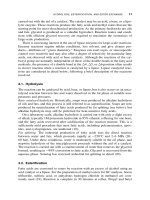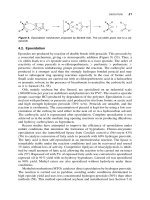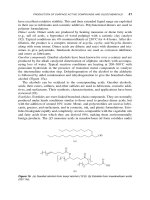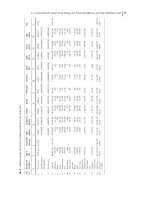bailey s industrial oil and fat products sixth edition phần 4 pdf
Bạn đang xem bản rút gọn của tài liệu. Xem và tải ngay bản đầy đủ của tài liệu tại đây (121.02 KB, 13 trang )
have excellent oxidative stability. This and their extended liquid range are exploited
in their use as lubricants and cosmetic additives. Polyfunctional dimers are used in
polymer formulations.
Dimer acids. Dimer acids are produced by heating monoene or diene fatty acids
(e.g., tall oil acids, a byproduct of wood pulping) with a cationic clay catalyst
(92). Typical conditions are 4% montmorillonite at 230
C for 4–8 hours. After dis-
tillation, the product is a complex mixture of acyclic, cyclic, and bicyclic dimers
along with some trimer. Dimer acids are dibasic and react with diamines and tria-
mines to give polyamides. Imidazole derivatives are used as corrosion inhibitors
and esters as lubricants.
Guerbet compounds. Guerbet alcohols have been known for over a century and are
produced by the alkali catalyzed dimerization of aliphatic alcohols with accompa-
nying loss of water. Typical reaction conditions are heating at 200–300
C with
potassium hydroxide in the presence of transition metal compounds to catalyze
the intermediate reduction step. Dehydrogenation of the alcohol to the aldehyde
is followed by aldol condensation and rehydrogenation to give the branched-chain
alcohol (Figure 15a).
The alcohols can be oxidized to the corresponding acids. Guerbet alcohols,
acids, their esters, sulfates, and ether sulfates are used as lubricants, cosmetic addi-
tives, and surfactants. Their synthesis, characterization, and applications have been
reviewed (93).
Estolides. Estolides are ester-linked branched-chain compounds. They are normally
produced under harsh conditions similar to those used to produce dimer acids, but
with the addition of around 10% water. Mono- and polyestolides are used as lubri-
cants, greases, and surfactants, and in cosmetic, ink, and plastic formulations. Esto-
lides biodegrade rapidly and completely, at rates comparable with the vegetable oils
and fatty acids from which they are derived (94), making them environmentally
benign products. The Á5 monoene acids in meadowfoam oil form estolides under
OH
(a)
O
(b)
O
O
O
OH
O
13
13
13
n
Figure 15. (a) Guerbet alcohol from lauryl alcohol (12:0). (b) Estolide from meadowfoam acids
(20:1 5c).
PRODUCTION OF SURFACE ACTIVE COMPOUNDS AND OLEOCHEMICALS 31
mild acid catalysis, neighboring group participation by the carboxyl group facilitat-
ing the reaction (Figure 15b) (95). The product from meadowfoam acids shows
higher regioselectivity than that from acids with mid-chain olefins where the double
bond is further from the carboxyl group. Estolides from mid-chain olefins have sig-
nificantly lower pour points than the corresponding fatty acids or triacylglycerols,
but those from meadowfoam acids show little difference.
7. MODIFYING FATTY ACID STRUCTURE
Isomerization and conjugation change the properties of natural methylene-inter-
rupted fatty acids, leading to new applications and potential added value. Chain
shortening or extension produces fatty acids not readily isolated from natural
sources and is also used to introduce radioactive or stable isotope labels. Metathesis
provides a flexible method for modifying the alkyl chain.
7.1. Isomerization
Trans-isomers of fatty acids are more stable thermodynamically than cis-isomers,
because of reduced steric crowding; the equilibrium ratio is approximately 4:1
trans:cis. There is a considerable energy barrier to interconversion ($125 kJ/
mole). Before the attached groups can rotate about the double bond, it has to be
weakened by coordination to a catalyst, high temperature, or temporary conversion
to a single bond through addition and elimination reactions. Chemical isomeriza-
tion agents leading to an equilibrium mixture include selenium (through a p-com-
plex) and nitrogen oxides or thiols (through free-radical addition/elimination).
Cis-to trans-isomerization accompanies partial hydrogenation (see Section 5.2)
and may be exploited to raise the melting point. Unwanted isomerization occurs
during physical refining at temperatures above 250
C. More unsaturated acids iso-
merize faster, making linolenic containing seed oils (e.g., soybean and canola) par-
ticularly vulnerable. Conditions for deodorizing rape oil without isomerization have
been optimized following a detailed study and development of a model of the iso-
merization kinetics (96).
7.2. Conjugation
Heating with alkali has long been used to produce conjugated drying oils for paints
and varnishes. The anion resulting from removal of a bis-allylic methylene rear-
ranges through migration and isomerization, giving a cis,trans-conjugated system
(Figure 16). Thus, linoleic acid (18:2 9c12c) gives both 9c11t and 10t12c isomers,
whereas trienes give a mixture of partially and fully conjugated isomers depending
on whether the middle or an outer double bond migrates first. Under the harsh con-
ditions used to prepare drying oils (aqueous alkali at $230
C), a complex mixture
of isomers is eventually formed, but under controlled conditions (e.g., KOH in
32 CHEMISTRY OF FATTY ACIDS
propylene glycol at 150
C), a mixture containing only the 9c11t and 10t12c CLA
isomers is produced (97). This product and individual isomers prepared from the
mixture are used as nutritional supplements.
Thermal isomerization of linoleic acid produces a conjugated isomer mixture
that does not contain all possible cis-and trans-isomers. The absence of the 8c10t
and 11t13c isomers suggests a concerted pericyclic mechanism that limits the geo-
metrical possibilities for the rearranged double bonds (98). [RhCl(C
8
H
14
)
2
]
2
in the
presence of (p-CH
3
C
6
H
4
)
3
P and SnCl
2
.2H
2
Oisanefficient homogeneous catalyst
for the conjugation of linoleic acid, producing conjugated soybean oil with excep-
tional drying properties and high solvent resistance in high yield (99).
7.3 Chain Shortening and Extension
Fatty acids can be labeled at the carboxyl carbon with
13
Cor
14
C by chain short-
ening followed by chain extension with labeled carbon. Chain shortening to the nor-
halide using the Hunsdieker reaction (decarboxylation of fatty acid silver salts in
the presence of halogens) is only suitable for saturated acids, but unsaturation is
not altered using the alternative developed by Barton employing N-hydroxy-pyri-
dine-2-thione in a halocarbon solvent (100). Chain extension with labeled cyanide
followed by hydrolysis or reaction of the derived Grignard reagent with labeled car-
bon dioxide gives the labeled fatty acid. The Barton decarboxylation was recently
used to prepare gram quantities of 1-[
13
C ]-linoleic and 1-[
13
C ]-linolenic acids for
metabolic studies (101).
Two-carbon chain extension at the carboxyl end, mimicking biosynthesis, uses
the malonic ester route (102). After reduction of the carboxyl to an alcohol, the
readily displaced mesylate is prepared and reacted with sodium diethylmalonate.
Saponification and decarboxylation gives the chain extended product in high yield.
OH
+
H
2
O
+
Figure 16. Alkali-induced conjugation of methylene-interrupted olefins.
MODIFYING FATTY ACID STRUCTURE 33
This is an efficient route to C
20
polyenes, not easily isolated from natural sources,
starting from readily available C
18
sources.
Metathesis (see Section 7.4) provides a flexible route to longer and shorter
chains after reaction at a (usually monoene) double bond.
7.4 Olefin Metathesis
Olefin metathesis is the catalytic exchange of groups attached to a double bond. It
presents a number of interesting possibilities for modifying the alkyl chain of fatty
acids (Figure 17).
The mechanism involves a [2,2] cycloaddition between a transition metal alky-
lidene complex and the olefin, resulting in an intermediate metallocyclobutane
(103). The metallocycle breaks in the opposite way to give a new alkylidene and
a new olefin. Repeated exchange at the metal results in an equilibrium mixture
of olefins, usually as an equilibrium mixture of cis-and trans-isomers. The reaction
is used in the petrochemical industry to modify hydrocarbon structure, using cata-
lysts such as WCl
6
/SnMe
4
or Re
2
O
7
/Al
2
O
3
. These catalysts are less active when
other functional groups compete for the active site, and the application of metath-
esis in oleochemistry has paralleled development of novel catalysts, such as Grubb
catalysts, containing sterically hindered metal alkylidenes (Figure 17a,b).
Self-metathesis describes the reaction of an unsaturated fatty acid with itself.
For example, methyl oleate gives a mixture of starting material (50%), unsaturated
hydrocarbon (25%), and long-chain unsaturated diester (25%), all as a mixture
of cis-and trans-isomers. (Figure 18). The diester can be converted to the musk
component civetone, but a more efficient route is through self metathesis of
the ketone oleon derived from methyl oleate by Claisen condensation (104)
(Figure 18).
catalyst
R
HH
R′ R
HH
R
R′
HH
R′
+
R′
R′′
R′
L
n
M
R′′
L
n
M
R′
R
L
n
MC
R
R′′
+
R
Ph
PhRu
PR
3
PR
3
Cl
Cl
(a)
Ph
Ru
PCy
3
Cl
Cl
(b)
NN
Mes Mes
Figure 17. Olefin metathesis reaction and mechanism. (a) and (b) Grubb catalysts.
34 CHEMISTRY OF FATTY ACIDS
Cross-metathesis of an unsaturated fatty ester with a normal alkene is a versatile
way of producing chain-shortened or chain-extended homologues leading to oleo-
chemicals with chain lengths outside the C
16
–C
22
range of most commodity oils.
Methyl oleate reacts with hex-3-ene, in large excess to suppress self-metathesis and
push the reaction toward the C
12
ester and hydrocarbon products. o-Olefins may be
chain extended similarly, the ethene produced being removed to drive the reaction
to completion. Cross metathesis provides a route to compounds otherwise difficult
to obtain, for example, triacontanol from reduction of the product from methyl eru-
cate and 1-octadecene. Ethenolysis (cross-metathesis with ethene) produces shorter
chain o-olefins with a wide range of applications. A high pressure of ethene is used
to force the reaction to the desired products. o-Olefins produced either by metath-
esis or from pyrolysis of castor oil can be coupled to give long-chain dibasic acids
(105).
Metathesis of intact oils produces polymeric products resulting from intra- and
intermolecular bond formation, and they can be used to produce high-viscosity
stand oils from drying oils without the loss of double bonds that occurs on thermal
polymerization. Vegetable oils can be metathesized efficiently at low temperature
and pressure using Grubb’s ruthenium catalyst (Cy
3
P)
2
Cl
2
Ru
ÀÀ
ÀÀ
CHPh, without the
rigorous exclusion of water and oxygen required with WCl
6
/SnMe
4
(106). Pretreat-
ment of the oil with silica gel may be required.
As a reaction with 100% atom efficiency achieved at moderate temperature
(<100
C) using renewable resources, metathesis has potential in a sustainable
COOMe
MeOOC
COOMe
O
O
× 2
Re
2
O
7
/SiO
2
, Al
2
O
3
/Bu
4
Sn
oleon
civetone
+
Figure 18. Self-metathesis reactions.
MODIFYING FATTY ACID STRUCTURE 35
chemical industry. A recently developed catalyst (Figure 17b) has an efficiency that
justifies industrial application in the production of fine chemicals (106). The hydro-
carbon byproducts of metathesis, for example, a -olefins, are also valuable starting
materials. Metathesis in oleochemistry, in the context of green chemistry, has
recently been reviewed (107).
8. NOVEL CHEMISTRY FOR FUNCTIONALIZING
THE ALKYL CHAIN
Oils and fats are renewable resources for the chemical industry. Increasing the
range of oleochemicals that can be produced could add value to existing crops
and provide a market for new crops, driving research into novel fatty acid deriva-
tives. Most current oleochemical production involves reaction at the carboxyl
group, with the chain length and unsaturation of the alkyl chain chosen to give
the desired melting behavior or hydrophobicity. Introducing functionality to the
alkyl chain through radical, electrophilic, nucleophilic, pericyclic, and transition
metal catalyzed addition to carbon–carbon double bonds leads to novel compounds
with commercial potential. Only a small selection of recent research is illustrated
here, focusing on three promising approaches: neighboring group participation,
Friedel Crafts acylation, and free-radical addition reactions.
Functionalizing the alkyl chain places more emphasis on the structure of the
fatty acids used as feedstock. Model reactions use single fatty acids, often mono-
enes with particular double-bond positions. Large-scale use of these reactions needs
oils rich in single fatty acids to maintain the purity of the product and minimize
wasteful side reactions. Suitable feedstocks may be current crops such as high oleic
or high erucic varieties or new crops with unusual fatty acids (Chapter xx). Petro-
selenic acid (18:1 6c) from umbelliferae oils and 5-eicosenoic acid (20:1 5c) from
meadowfoam oil are of particular interest as distinctive products can result from
neighboring group participation. Breeding to increase the monoene content of
some oils may be desirable. o-Olefins are useful starting materials; 10-undecenoic
acid is available from pyrolysis of castor oil, and others may be produced by
metathesis (see Section 7.4). Recent, wide-ranging reviews of this area are available
(4, 5, 108)
8.1. Neighboring Group Participation
Neighboring group participation is the involvement of a nearby functional group in
the reaction of another functional group. It may influence the regioselectivity of the
reaction or lead to specific products, often as a result of cyclization to five-and six-
membered rings. Neighboring group participation reactions of fatty acids were
reviewed recently (109) and can be used to introduce mid-chain functionality,
including heterocyclic groups. Double bonds and the carboxyl group usually react
independently of each other, but Á4 and Á5 bonds may interact with the carboxyl
through neighboring group participation leading to g- and d-lactones (five- and
36 CHEMISTRY OF FATTY ACIDS
six-membered rings, respectively). The Á5 acids from meadowfoam oil readily
form lactones when refluxed with perchloric acid. The proportion of d- and
g-lactones depends on the solvent: 6:1 in hexane and 40:1 in dichloromethane.
The d-lactone is formed faster, but the g-lactone is the more thermodynamically
stable isomer. High dilution and a nonparticipating polar solvent that stabilizes
the intermediate cation favor kinetic control of the reaction (110). The lactones
can be ring opened by treatment with water, alcohols, and amines in acid, giving
4- and 5-hydroxy acids, esters, and amides (111); alternatively, treatment with an
alcohol and a Lewis acid catalyst under more vigorous conditions results in an alkyl
group ether linked to the chain (112) (Figure 19).
8.2. Friedel Crafts Acylation
Friedel Crafts acylation with an acyl chloride and Lewis acid catalyst is more often
associated with aromatic compounds. Ethylaluminium dichloride (EtAlCl
2
)isan
effective catalyst for the acylation of aliphatic olefins, including fatty acids and
alcohols, giving b,g-unsaturated ketones (113). The reaction occurs with both
terminal and internal double bonds, with the acyl group becoming attached to
one of the double-bond carbons while the double bond migrates one carbon. Reac-
tion at terminal olefins is regiospecific with addition to the terminal carbon giving a
linear product and a predominantly trans-double bond. Internal double bonds give
an approximately equal mixture of trans-regioisomers (Figure 19). a,b-Unsaturated
acid chlorides give allyl vinyl ketones that undergo Nazarov cyclization to prosta-
glandin- and jasmonate-like molecules (Figure 20) (114). Neighboring group parti-
cipation in petroselenic acid (18:1 6c) leads to intramolecular cyclization (115).
Friedel Crafts acylation is a flexible route to new and highly functionalized oleo-
chemicals containing reactive allyl keto functions (115).
OH
O
14
OO
X
OOH
14
OR
OOR
HX
H
+
ROH
Lewis acid
HClO
4
CH
2
Cl
2
Figure 19. Neighboring group participation leading to lactones and other products from Á5
acids. X ¼ OH, RO, or RNH.
NOVEL CHEMISTRY FOR FUNCTIONALIZING THE ALKYL CHAIN 37
8.3. Free Radical Addition Reactions
Double bonds participate in free radical addition reactions, and these can be of syn-
thetic use in introducing functional groups (116). A particularly simple reaction is
the preparation of g-lactones by solvent-free addition of 2-halocarboxylates to fatty
esters, catalyzed by commercial copper powder at 100–130
C (117). Iodides are
most reactive and can be prepared in situ from more readily available bromides
and sodium iodide (Figure 21).
Perfluoro alkyl iodides add to both terminal and internal double bonds when the
reaction is initiated by electron transfer from metals such as finely divided silver,
copper powder, and lead with copper acetate. Using an o-olefin and a perfluoro-
alkyl-a,o-diiodide, a perfluoro group can be inserted into a long-chain compound
(118) (Figure 21). Deiodination of the product by catalytic reduction results in
highly hydrophobic alkyl chains with interesting surfactant properties.
OH
O
R
O
OH
O
910
11
10
RCl
O
10
11
+
10
9
EtAlCl
2
COOH
Cl
O
COOH
O
H
3
PO
4
/HCOOH
COOH
O
(+ regioisomer)
(+ regioisomer)
EtAlCl
2
Figure 20. Friedel Crafts acylation reactions.
38 CHEMISTRY OF FATTY ACIDS
REFERENCES
1. C. C. Akoh and D. B. Min, eds., Food Lipids: Chemistry, Nutrition, and Biotechnology,
2nd ed., Marcel Dekker, Inc., New York, 2002.
2. F. D. Gunstone, Eur. J. Lipid Sci. Technol., 103, 307–314 (2001).
3. F. D. Gunstone and R. J. Hamilton, eds., Oleochemical Manufacture and Applications,
Sheffield Academic Press, Sheffield, U.K., 2001.
4. U. Biermann, W. Friedt, S. Lang, W. Lu
¨
hs, G. Machmu
¨
ller, J. O. Metzger, M. Ru
¨
sch gen.
Klaas, H. J. Scha
¨
fer, and M. P. Schneider, Angew. Chem. Int. Ed., 39, 2206–2224 (2000).
5. G. Knothe and J. T. P. Derksen, eds., Recent Developments in the Synthesis of Fatty Acid
Derivatives, AOCS Press, Champaign, Illinois, 1999.
6. F. D. Gunstone and F. B. Padley, eds., Lipid Technologies and Applications, Marcel
Dekker, Inc., New York, 1997.
7. A. Karleskind, ed., Oils and Fats Manual, Vols. 1 and 2, Intercept Ltd., Andover, U.K.,
1996.
8. F. D. Gunstone, Fatty Acid and Lipid Chemistry, Blackie Academic and Professional,
London, U.K., 1996.
OH
O
OH
O
10
11
+
Cu
H
2
Pd/C
COOMe
I
O
O
OMe
O
10
11
2 + I(CF
2
)
n
I
Pb/Cu(OAc)
2
MeOOC
(CF
2
)
n
COOMe
II
77
MeOOC
(CF
2
)
n
COOMe
Figure 21. Radical addition reactions.
REFERENCES 39
9. F. D. Gunstone, J. L. Harwood, and F. B. Padley, eds., The Lipid Handbook, 2nd ed.,
Chapman and Hall, London, U.K., 1994.
10. H. Baumann, M. Bu
¨
hler, H. Fochem, F Hirsinger, H. Zoebelein, and J. Falbe, Angew.
Chem. Int. Ed., 27,41–62 (1988).
11. Official Methods and Recommended Practices of the American Oil Chemists’ Society,
Section I, American Oil Chemists’ Society, Champaign, Illinois, 1997.
12. E. Ucciani, Dictionnaire des Huiles Ve
´
ge
´
tales, Lavoisier Publishing, Paris, 1995.
13. R. O. Adlof and F. D. Gunstone. (2001). Available: />division/analytic/fanames.htm.
14. M. J. Parnham, Inform 7, 1168–1175 (1996).
15. Official Methods and Recommended Practices of the American Oil Chemists’ Society,
Fifth Edition, Sections Cd 1 and Cd 3, American Oil Chemists’ Society, Champaign,
Illinois, 1998.
16. H. Li, F. R. van de Voort, A. A. Ismail, J. Sedman, R. Cox, C. Simard, and H. Buijs, J.
Amer. Oil Chem. Soc., 77,29–36 (2000).
17. H. Li, F. R. van de Voort, J. Sedman, and A. A. Ismail, J. Amer. Oil Chem. Soc., 76, 491–
497 (1999).
18. M. H. Gordon, in M. Jee, ed., Oils and Fats Authentication, Blackwell, Oxford, 2002,
pp. 143–155.
19. W. W. Christie Lipid Analysis, The Oily Press, Bridgwater, UK, 3rd Edition, in press
2002.
20. N. O. V. Sonntag, in R. W. Johnson and E. Fritz, eds., Fatty Acids in Industry, Marcel
Dekker, Inc., New York, 1988. pp. 23–72.
21. D. R. Kodali, J. Lipid Res., 28, 464–469 (1987).
22. F. D. Gunstone, in F. D. Gunstone, ed., Lipid Synthesis and Manufacture, Sheffield
Academic Press, Sheffield, U.K., 1999, pp. 321–346.
23. W. W. Christie. (2002, April 29). The Lipid Library. Available: />infores/select.html.
24. Y. M. Choo, A. N. Ma, and A. S. H. Ong, in F. D. Gunstone and F. B. Padley, eds., Lipid
Technologies and Applications, Marcel Dekker, Inc., New York, 1997, pp. 771–773.
25. G. Knothe and R. O. Dunn, in F. D. Gunstone and R. J. Hamilton, eds., Oleochemical
Manufacture and Applications, Sheffield Academic Press, Sheffield, U.K., 2001,
pp. 128–132.
26. K L. Lee, T. A. Foglia, and Y S. Chang, J. Amer. Oil Chem. Soc., 79, 191–195 (2002).
27. Y. Watanabe, Y. Shimada, A. Sugihara, and Y. Tominga, J. Amer. Oil Chem. Soc., 78,
703–707 (2001).
28. A. Rozendaal and A. R. Macrae, in F. D. Gunstone and F. B. Padley, eds., Lipid
Technologies and Applications, Marcel Dekker, Inc., New York, 1997, pp. 223–245.
29. D. Rousseau and A. G. Marangoni, in C. C. Akoh and D. B. Min, eds., Food Lipids:
Chemistry, Nutrition, and Biotechnology, 2nd ed., Marcel Dekker, Inc., New York, 2002,
pp. 301–333.
30. F. D. Gunstone, J. Sci. Food Agric., 79, 1535–1549 (1999).
31. X. Xu, Eur. J. Lipid Sci.Technol., 102, 287–303 (2000).
32. C. F. Torres, E. Barrios, and C. G. Hill, J. Amer. Oil Chem. Soc., 79, 457–466 (2002).
40
CHEMISTRY OF FATTY ACIDS
33. C. C. Akoh and X. Xu, in T. M. Kuo and H. W. Gardner, eds., Lipid Biotechnology,
Marcel Dekker, Inc., New York, 2002, pp. 461–469.
34. M. W. Christensen, L. Andersen, O. Kirk, and H. C. Holm, Lipid Technol. Newslett., 7,
33–37 (2001).
35. P. M. Nielsen, Oils and Fats International, July,18–19 (2002).
36. Y. Shimada, N. Fukushima, H. Fujita, Y. Honda, A. Sugihara, and Y. Tominga, J. Amer.
Oil Chem. Soc., 75, 1581–1586 (1998).
37. Y. Shimada, A. Sugihara, M. Shibahiraki, H. Fujita, H. Nakano, T. Nagao, T. Terai, and
Y. Tominaga, J. Amer. Oil Chem. Soc., 74, 1465–1470 (1997).
38. Y H. Ju and T C. Chen, J. Amer. Oil Chem. Soc., 79,29–32 (2002).
39. Y. Shimada, K. Maruyama, A. Sugihara, T. Baba, S. Komemushi, S. Moriyama, and
Y. Tominaga, J. Amer. Oil Chem. Soc., 75, 1565–1571 (1998).
40. S. A. Spurvey, S. P. J. N. Senanayake, and F. Shahidi, J. Amer. Oil Chem. Soc., 78, 1105–
1112 (2001).
41. E. N. Frankel, Lipid Oxidation, The Oily Press, Dundee, U.K., 1998.
42. E. N. Frankel, Lipid Oxidation, The Oily Press, Dundee, U.K., 1998, pp. 19 and 43–54.
43. E. N. Frankel, J. Oleo Sci., 50, 387–391 (2001).
44. K. Miyashita, Lipid Technol. Newslett., 8,35–41 (2002).
45. T. I. Ha
¨
ma
¨
la
¨
inen, S. Sundberg, T. Hase, and A. Hopia, Lipids, 37, 533–540 (2002).
46. A. Bodin, M. Linnerborg, J. L. G. Nilsson, and A. T. Karlberg, J. Surfactants Deterg., 5,
107–110 (2002).
47. H. R. Rawls and P. J. Van Santen, J. Amer. Oil Chem. Soc., 47, 121–125 (1970).
48. F. H. Doleiden, S. R. Farenholtz, A. A. Lamola, and A. M. Trozzolo, Photochem.
Photobiol., 20, 519–521 (1974).
49. D. B. Min, in C. C. Akoh and D. B. Min eds., Food Lipids: Chemistry, Nutrition and
Biotechnology, Marcel Dekker, Inc., New York, 1998, pp. 289–292.
50. N. Macfarlane, J. Salt, R. Birkin, and A. Kendrick, Inform, 12, 244–249 (2001).
51. P. Schuler, in B. J. F. Hudson ed., Food Antioxidants, Elsevier, London, U.K., 1999,
pp. 138–141.
52. E. A. Decker and D. J. McClements, Inform, 12, 251–256 (2001).
53. P. D. Bartlett, Rec. Chem. Prog., 11,47–51 (1950).
54. S P. Chang, J. Amer. Oil Chem. Soc., 56, 855–856 (1979).
55. K. D. Karlson, R. Kleiman, and M. O. Bagby, J. Amer. Oil Chem. Soc., 71,175–182 (1994).
56. S. Warwel and M. Ru
¨
sch gen. Klass, J. Mol. Catal. B, 1,29–35 (1995).
57. M. Ru
¨
sch gen. Klass and S. Warwel, J. Amer. Oil Chem. Soc., 73, 1453–1457 (1996).
58. J. Rudolph, K. L. Reddy, J. P. Chiang, and K. B. Sharpless, J. Amer. Chem. Soc., 119,
6189–6190 (1997).
59. M. D. Refvik and R. C. Larock, J. Amer. Oil Chem. Soc., 76,99–102 (1999).
60. M. Ru
¨
sch gen. Klass and S. Warwel in G. Knothe and J. T. P. Derksen, eds., Recent
Developments in the Synthesis of Fatty Acid Derivatives, AOCS Press, Champaign,
Illinois, 1999, pp. 157–167.
61. G. J. Piazza, in G. Knothe and J. T. P. Derksen, eds., Recent Developments in the
Synthesis of Fatty Acid Derivatives, AOCS Press, Champaign, Illinois, 1999, pp. 182–
195.
REFERENCES 41
62. H. C. Brown and A. K. Mandal, Synthesis, 153–155 (1980).
63. R. Wilson, R. Smith, P. Wilson, M. J. Shepherd, and R. A. Riemersma, Anal. Biochem.,
248,76–85 (1997).
64. J. Brinksma, L. Schmieder, G. van Vliet, R. Boaron, R. Hage, D. E. DeVos, P. L. Alsters,
and B. L. Feringa, Tetrahedron Lett., 43, 2619–2622 (2002).
65. C. T. Hou, T. M. Kuo, and A. C. Lanser, Inform, 13, 307–316 (2002).
66. R. Criegee, Angew. Chem. Int. Ed., 14, 745–752 (1975).
67. B. S. Furniss, A. J. Hannaford, P. W. G. Smith, and A. R. Tatchell, Vogel’s Textbook of
Practical Organic Chemistry, Longman, Harlow, U.K., 1989, pp. 492–494.
68. L. Rebrovic, J. Amer. Oil Chem. Soc., 69, 159–165 (1992).
69. L. Rebrovic and F. D. Gunstone, Lipid Technol., 8, 135–137 (1996).
70. H P. Klein, J. Amer. Oil Chem. Soc., 61, 306–312 (1984).
71. S. Warwel and M. Ru
¨
sch gen. Klass, Lipid Technol., 9,10–14 (1997).
72. M. Ru
¨
sch gen. Klass and S. Warwel, in G. Knothe and J. T. P. Derksen, eds., Recent
Developments in the Synthesis of Fatty Acid Derivatives, AOCS Press, Champaign,
Illinois, 1999, pp. 167–173.
73. B. F. Dickens, C. S. Ramesha, and G. A. Thompson, Anal. Biochem., 127,37–48
(1982).
74. J. L. Se
´
be
´
dio, P. Juane
´
da, S. Gre
´
goire, J. M. Chardigny, J. C. Martin, and C. Ginies,
Lipids, 34, 1319–1325 (1999).
75. A. J. Dijkstra, in K. K. Rajah, ed., Fats in Food Technology, Sheffield Academic Press,
Sheffield, U.K., 2002, pp. 123–141.
76. A. J. Dijkstra, Inform, 8, 1150–1158 (1997).
77. W. T. Koetsier, in F. D. Gunstone and F. B. Padley, eds., Lipid Technologies and
Applications, Marcel Dekker, Inc., New York, 1997, pp. 265–303.
78. A. J. Dijkstra, Eur. J. Lipid Sci. Technol., 104,29–35 (2002).
79. U. R. Kreutzer, J. Amer. Oil Chem. Soc., 61, 343–348 (1984).
80. R. W. Johnson, in R. W. Johnson and E. Fritz, eds., Fatty Acids in Industry, Marcel
Dekker, Inc., New York, 1988, pp. 217–231.
81. M. R. Porter, in F. D. Gunstone and F. B. Padley, eds., Lipid Technologies and
Applications, Marcel Dekker, Inc., New York, 1997, pp. 579–608.
82. A. D. James, in F. D. Gunstone and F. B. Padley, eds., Lipid Technologies and
Applications, Marcel Dekker, Inc., New York, 1997, pp. 609–631.
83. G. Bogndo, in F. D. Gunstone and F. B. Padley, eds., Lipid Technologies and Applica-
tions, Marcel Dekker, Inc., New York, 1997, pp. 633–694.
84. R. Franklin, M. D. Hoey, and J. Zachwieja, in F. D. Gunstone and R. J. Hamilton, eds.,
Oleochemical Manufacture and Applications, Sheffield Academic Press, Sheffield,
U.K., 2001, pp. 23–54.
85. D. W. Roberts, in F. D. Gunstone and R. J. Hamilton, eds., Oleochemical Manufacture
and Applications, Sheffield Academic Press, Sheffield, U.K., 2001, pp. 55–73.
86. S. Billenstein and G. Blaschke, J. Amer. Oil Chem. Soc., 61, 353–357 (1984).
87. L. Dahlgren, Inform, 11, 508–512 (2000).
88. K. Hill, Agro-Food Industry Hi-Tech., September/October,9–15 (1998).
89. K. Hill and O. Rhode, Fette/Lipid, 101,25–33 (1999).
42
CHEMISTRY OF FATTY ACIDS
90. K. Hill, W. von Rybinski, and G. Stoll, eds., Alkyl Polyglycosides, VCH, Weinheim,
FRG, 1997.
91. W. von Rybinski and K. Hill, Angew. Chem. Int. Ed., 37, 1328–1345.
92. R. W. Johnson, in R. W. Johnson, and E. Fritz, eds., Fatty Acids in Industry, Marcel
Dekker, Inc., New York, 1988, pp. 153–175.
93. G. Knothe, Lipid Technol., 14, 101–104 (2002).
94. S. M. Erhan and R. Kleiman, J. Amer. Oil Chem. Soc., 74, 605–607 (1997).
95. T. A. Isbell and R. Kleiman, J. Amer. Oil Chem. Soc., 73, 1097–1107 (1996).
96. G. He
´
non, Z. Keme
´
ny, K. Recseg, F. Zwobada, and K. Kovari, J. Amer. Oil Chem. Soc.,
76,73–81 (1999).
97. A. Sæbø, Lipid Technol. Newslett., 7,9–13 (2001).
98. F. Destaillats and P. Angers, Lipids, 37, 435–438 (2002).
99. R. C. Larock, X. Dong, S. Chung, C. K. Reddy, and L. E. Ehlers, J. Amer. Oil Chem. Soc.,
78, 447–453 (2001).
100. D. H. R. Barton, D. Critch, and W. B. Motherwell, Tetrahedron Lett., 24, 4979–4982
(1983).
101. O. Loreau, A. Maret, D. Poullain, J. M. Chardigny, J.L. Se
´
be
´
dio, B. Beaufre
`
re, and J. P.
Noe
¨
l, Chem. Phys. Lipids, 106,65–78 (2000).
102. F. Spener and H. K. Mangold, Chem. Phys. Lipids, 11, 215–218 (1973).
103. R. Toreki. (2002, July 3). Organometallic HyperTextBook. Available i.
com/organomet/olmetathesis.html.
104. M. F. C. Plugge and J. C. Mol, Synlett, 507–508 (1991).
105. S. Warwel, H. G. Jagers, and S. Thomas, Fat Sci. Technol., 94, 323–328 (1992).
106. M. D. Refvik, R. C. Larock, and Q. Tian, J. Amer. Oil Chem. Soc., 76,93–98 (1999).
107. J. C. Mol, Green Chem., 4,5–13 (2002).
108. U. Biermann, S. Fu
¨
rmeier, and J. O. Metzger, in F. D. Gunstone and R. J. Hamilton, eds.,
Oleochemical Manufacture and Applications, Sheffield Academic Press, Sheffield,
U.K., 2001, pp. 266–299.
109. F. D. Gunstone, in G. Knothe and J. T. P. Derksen, eds., Recent Developments in the
Synthesis of Fatty Acid Derivatives, AOCS Press, Champaign, Illinois, 1999, pp. 1–19.
110. T. A. Isbell and B. A. Plattner, J. Amer. Oil Chem. Soc., 74, 153–158 (1997).
111. T. A. Isbell and B. A. Steiner, J. Amer. Oil Chem. Soc., 75,63–66 (1998).
112. T. A. Isbell and M. S. Mund, J. Amer. Oil Chem. Soc., 75, 1021–1029 (1998).
113. J. O. Metzger and U. Biermann, Liebigs Ann. Chem., 645–650 (1993).
114. J. O. Metzger and U. Biermann, Fette/Lipid, 100,2–6 (1998).
115. U. Biermann and J. O. Metzger, in G. Knothe and J. T. P. Derksen, eds., Recent
Developments in the Synthesis of Fatty Acid Derivatives, AOCS Press, Champaign,
Illinois, 1999, pp. 80–89.
116. J. O. Metzger, R. Mahler, G. Francke, and A. Hayen, in G. Knothe and J. T. P. Derksen,
eds., Recent Developments in the Synthesis of Fatty Acid Derivatives, AOCS Press,
Champaign, Illinois, 1999, pp. 90–99.
117. J. O. Metzger, R. Mahler, and G. Francke, Liebigs Ann./Recueil, 2303–2313 (1997).
118. J. O. Metzger, R. Mahler, and A. Schmidt, Liebigs Ann. Chem., 693–696 (1996).
REFERENCES 43









